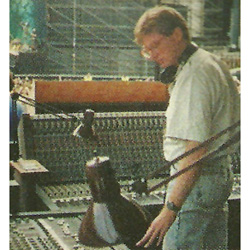
Ron B: How did you happen to get some of those big name mixing gigs, being so far removed geographically from the music biz?
Bruce: I started working with overseas acts, such as Bill Cosby, Odetta, along with interesting local projects, such as the local Daily Wilson Big Band. When Roy Clair turned up in Australia, it was my first introduction to big PA systems, although in hindsight, it was actually pretty small. I then kept the sound system in Australia and did a tour with Johnny Cash, Mother Maybell, and the Carter Family, along with the Statler Brothers and Carl Perkins. I was traveling to London and Roy said to stop off on the way. At the time, sound companies rarely did National wide tours; when an act came into a sound companies area, that sound company would cover all its local cities. For example, Showco did the Texas area, Tycobrae and McCune did California, and so on.
P Tucci: You’re talking 1968 here?
Bruce: I met up with Roy Clair right around 1970. My break came with Elvis Presley. When other sound companies were having trouble, and the show didn’t see us having all the same troubles – back in those days equipment reliability was really dubious – so next thing, I was asked to travel around with the show and work with the other sound companies in the different areas. That progressed to me being asked to cover all the shows with Clair Brothers.
Tony Pybus: What equipment would have been used at that time?
Bruce: The amplifiers were by SAE, the loudspeakers were a combination of Altec and mostly JBL. we were even using multi-cell horns and RCA-style W Boxes. The mixers were a variety of home built devices and some purchased from companies, such as Gatley.
Dave D: did you have much to do with the first CBA consoles? I believe at the time they came out, the “state of the art” was the Yamaha PM1000.
Bruce: I don’t think the Yamaha was around when we built the Clair Bros console. There were actually a few different Clair consoles that I was involved in. The one we made the most of was the Clair 32 channel. It was a project between Ron Borthwick and myself, plus a great crew. Ron is still at Clair Bros and is still Chief Engineer. We worked really well together because I would come up with crazy ideas and he would kept me honest from an engineering point of view. We used to have some good fights in the process.
But it’s kind of like the dynamics of a rock ‘n roll band. Even though there’s all sorts of stress and tension, the result is it creates excitement and innovation. I think that’s true of any design project – you get the right team and the right energy and the synergy spits out something much better than any one of the individuals would necessarily do on their own.
Dave D: Were there production SAE consoles, or put together with by Clair with SAE circuits?
Bruce: There was never a production SAE console. SAE built conponents for a mixer that Clair Bros built around 1970. It was really just the SAE graphic EQ laid out on a card, and instead of sliders, for each frequency, as you would see on their graphic EQ, there were switches to select the desired frequency. There were no op amps in these cards, just simple 2-transistor amplifier stages. Consequently, they sounded great….
Dave D: …and discrete 3dB steps in boost/cut as I recall…
Bruce: It was continuous if my memory serves me.
Dave D: An early mentor of mine was a gentleman named Bob Albright, I believe he had a hand in building the CBA consoles.
Bruce: I don’t recall… Bob Albright…
Dave D: this is circa 1978
Bruce: That wouldn’t have been the CBA console, it may have been a project that I wasn’t involved in, that never saw the light of day. It was a digitally controlled analog board. Steve Dove had a lot to do with it, and also Jim Meyer who joined the project straight out of school. Jim was a big part of the iO/contour project.
Moderator: We’ll be shifting gears in a moment… A couple more comments/questions relating to times past.
Abdul EQ: That folding Clair console is like the Godfather of all TRANSFORMERS in Abdul’s eyes.
Bruce: I never thought of it that way. It was fun designing the mechanics, so that when it folded, all the knobs wouldn’t bang into each other. It has an unusual construction, consisting of a whole bunch of extrusions that are held together with tension rods from each end. Kind of like how you would hold a bunch of books together horizontally by pushing in from both sides with your hands.
